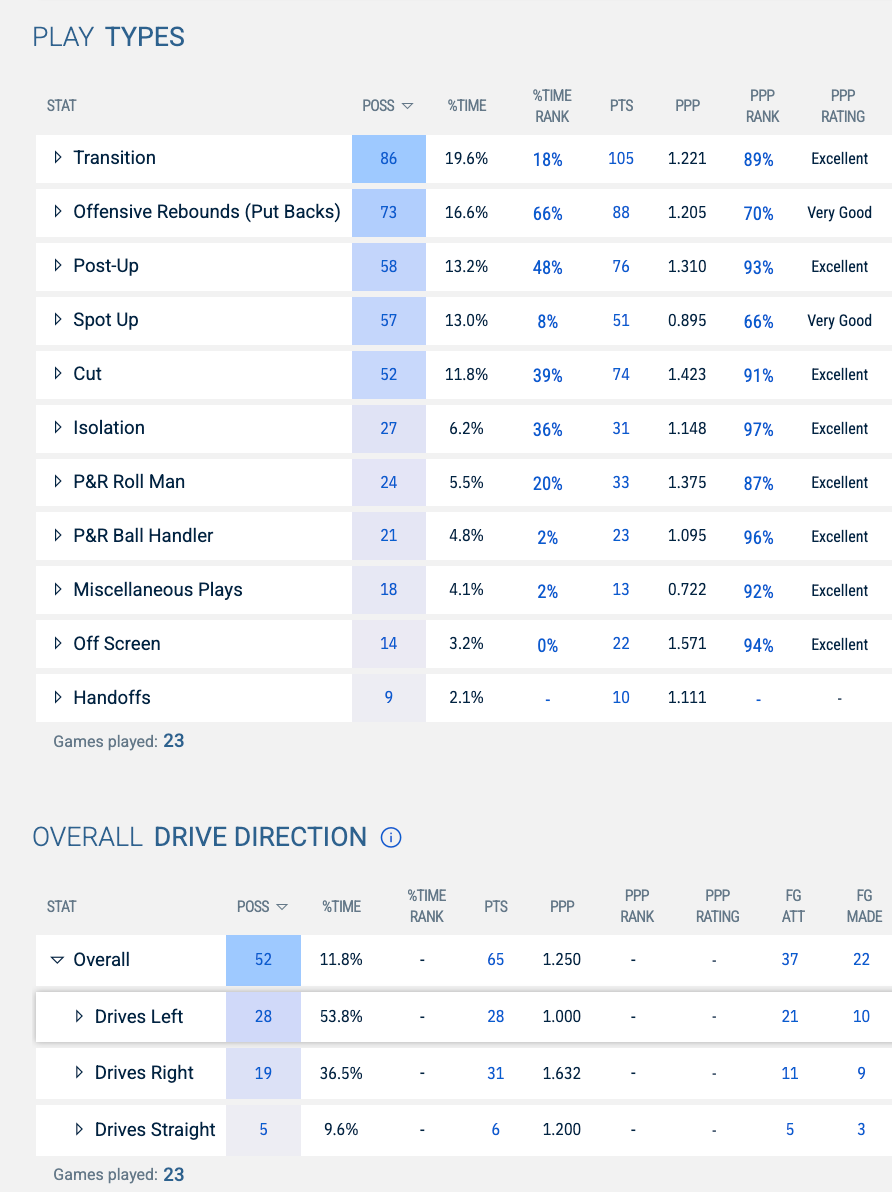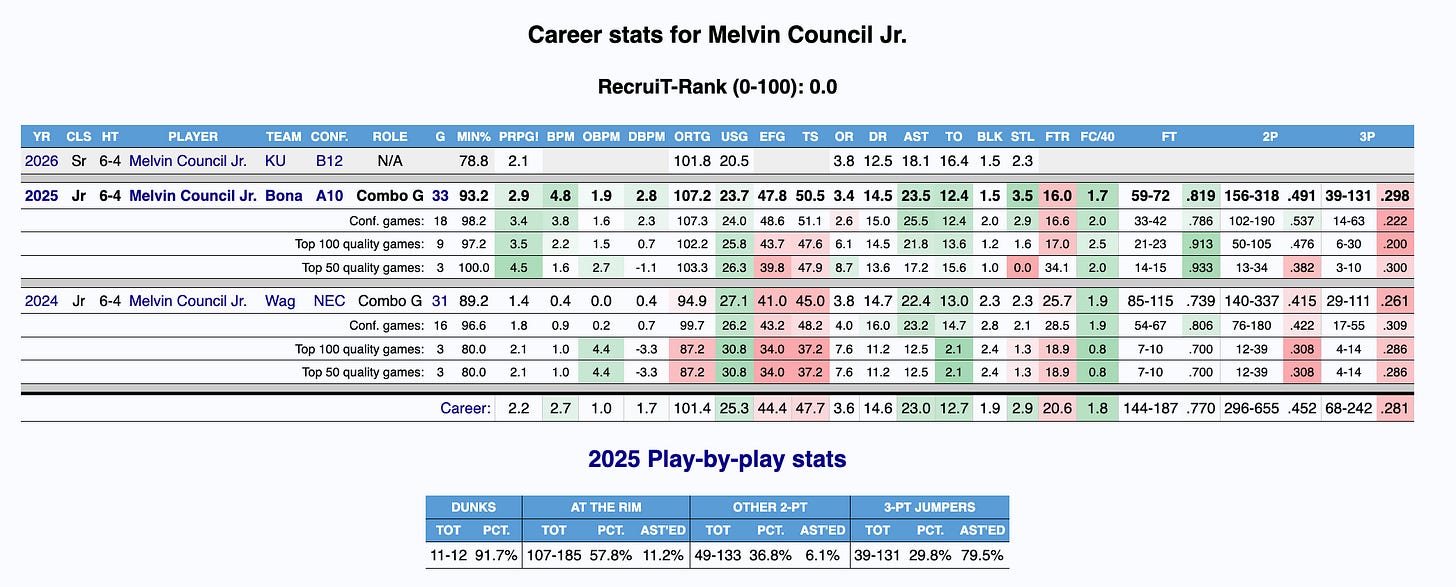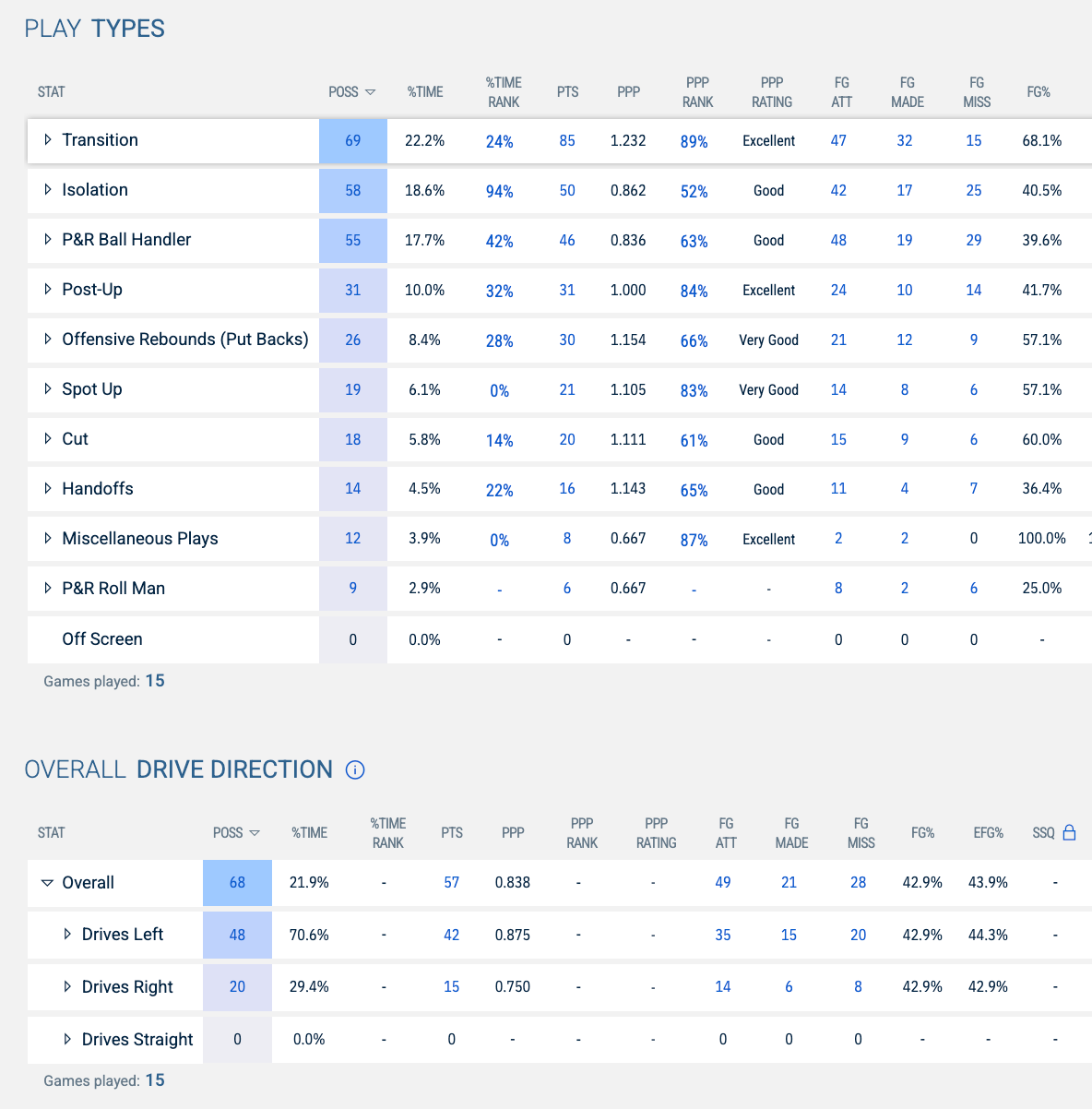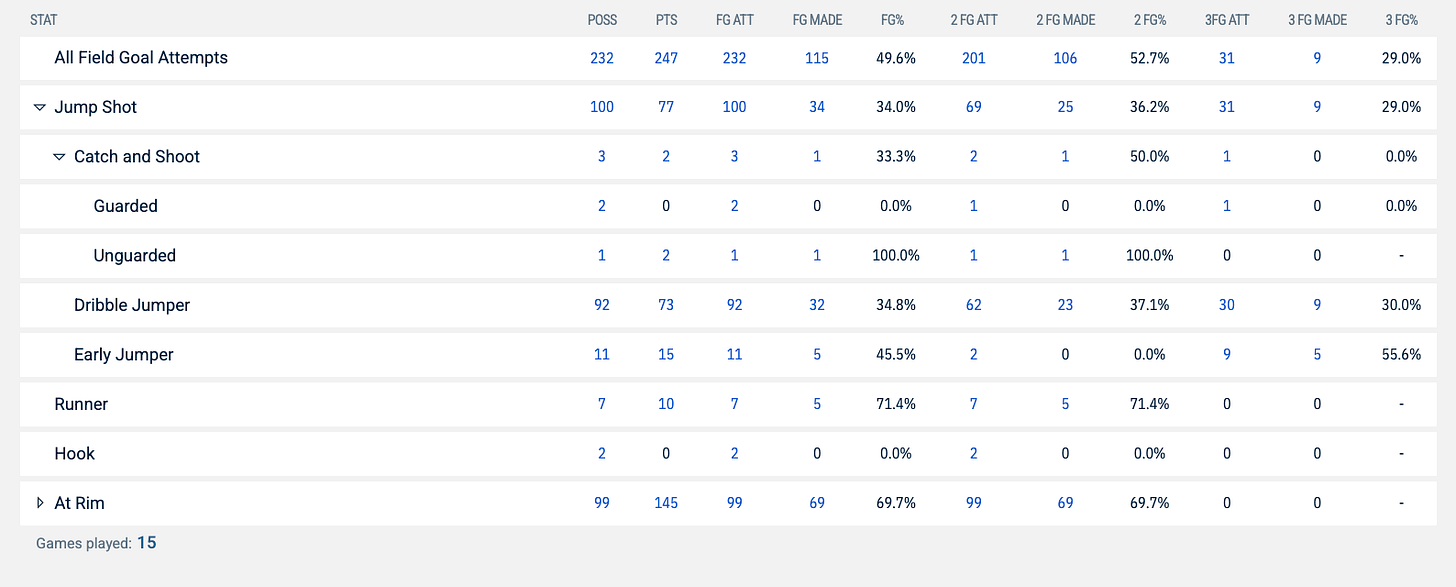2026 Draft Preview Writeup
My 14 Favorite Prospects
Pre-season boards are largely a waste of time, and I have never participated until this year. As many have stated, NCAA is king. AAU numbers are not granular or standardized enough to make high-confidence assertions without overwhelmingly clear deficits or strengths.
Still, I’ve spent quite a bit of time going through the numbers and clips for these players. I have discussed every freshman listed here on The Double Bonus, a draft podcast hosted by Finn Vandergriff. We have accumulated double digit hours speaking on these prospects, and I urge you to listen to those episodes to better understand my viewpoints and what to expect from a statistical and contextual standpoint.
The first episode can be found here:
Please do not take these rankings too seriously, and please note that I am far more tolerant of risk than I would be for a typical board placement. I am deliberately placing less weight on downside tails, and I’m instead focusing more on potential upside and how these players can best actualize their impact.
1. Cameron Boozer
Pressing Questions:
How many PnRs does he run?
Will he eclipse 30% usage?
What will his stock rates be?
How well can he score in transition?
Thoughts:
Boozer is firmly in the mix for greatest NCAA prospect ever … if he can provide competent stocks. Offensively, he is as complete as one can be for his size. He can be the best 250+ pound shooter ever, with a solid shot at 85+ FT%. His feel is ridiculous, and I fully expect him to rack up tons of assists from the top of the key.
85% FT+ on a huge sample of FTA would be a huge star signal, as it is rare for a player to have avenues to robust perimeter creation at this size. Would this archetype imply something like LeBron James with less hip fluidity/vertical athleticism and better touch? Bron was DPOY peak, but Boozer’s defensive rebounding is fairly all-time relative to AAU, and he had a 4% steal rate at the U17 WC. It’s unlikely, and it would require way more perimeter creation than we’ve seen, but it’s important to consider every single possible outcome.
Robust transition play would also be necessary, as this is where LeBron’s athleticism was highlighted. Boozer was more of an outlet passer in transition, as his presence allowed his teammates to feast there (see Caleb Wilson). LeBron’s all-time feel and athleticism have promoted his greatness; what does a less athletic version with better touch look like? This may seem like a preposterous question, but Boozer’s all time production profile deems him somewhat worthy… for now.
However, Boozer does have some tweener downside: his arms are way shorter than league-average for centers, and he’s not as fluid or explosive for his size. His 0 stock exhibition opening performance was slightly concerning, but much of this is because he is legitimately guarding on the perimeter. His block technique is phenomenal, and he can push over 1 block/foul. But while his feel will allow him to rack up stocks to some degree, I will be closely monitoring his ability to match up against bigs in the post. These feel-based, roaming stocks are great, but they become much more difficult with each subsequent rise in competition (see Cooper Flagg’s block rate over the last 4 years).
Statistically, Boozer is already the greatest AAU player of the modern era (where stats are available). He is comically efficient in every single possible playtype. I have never seen anything like this, and with his physicality and touch, I see absolutely no reason why he cannot scale up creationist usage and run PnRs/iso’s at an efficient clip. I fully expect to see one of the best collegiate seasons of all time.
2. Darryn Peterson
Pressing Questions:
How on-ball is he going to be?
Where does he land on the passing spectrum of true point guard to wing?
Thoughts:
Darryn Peterson is also firmly in the mix for greatest NCAA prospect ever … if we were to exclude his contemporaneous competition. He shot 88% FT in AAU with monstrous usage. He also averaged 4 stocks/game. Never have we seen this before.
Darryn’s offensive upside is strong, but he has some weaknesses. He is somewhat midrange reliant in the halfcourt, his shooting percentages trend on the lower side, and his assist to turnover rate is lower than Mr. Boozer. This is not a truly complete offensive profile.
But he had such preposterous usage. Usage and efficiency theoretically correlate, and he was facing true double teams consistently in 3SSB. If Darryn is the prospect we think he is, he will have to showcase stronger efficiency on 2s and 3s, as this sort of attention will be the norm. Still, that sort of FT% is unheard of, especially for a player of his dimensions. It indicates an outlier level of skill. Few heavily on-ball players have been able to hit 90% FT in the NBA, let alone in the NBA. If Darryn is able to do this, it would imply a very high level of shooting upside that would place him in all-time conversations. We need to see more turnover averse passing.
Not enough talk about Darryn’s ridiculous steal rate. My “cognition mass index” evaluatory paradigm rates Darryn very favorably by virtue of his massive positional size and cognition. He has wild feel for the game, and when you combine ridiculous cognition, applied mass, and touch, you have a recipe for all-time success.
Super high usage in NCAA is not a good thing, as it does not scale linearly. 35% USG vs 30% USG is a massive difference. Usage is simply the rate at which you finish your team’s possessions, and uber-high usage is more often an indictment on the relative team context rather than a player’s true on-ball upside. As such, we should not be rooting for mid 30s usage for Darryn or Cam (although Cam will jack up his usage with his putback volume- this will also increase his unassisted rate).
The issue is that Self did not do a particularly great job of complimenting Darryn with players capable of soaking up usage. Does Darryn completely embrace the Dajuan Harris role and “innings eat” for Self (expect an all-time micro assisted rate), or does he defer a little to Melvin Council?
Council can eat up unassisted volume, but he was so inefficient in the A10. His feel is clearly off the charts, and there is a good chance he can be playable in this role. But there is clear downside, and if the Council experiment is disastrous, we will see Darryn rack up insane usage. And I do not look forward to that, because overtaxing a player for the sake of development is cruel and poorly evidenced.
If Darryn simply maintains his general distribution of stats while passing better/making his FTs to the same degree, he can enter the all-time conversations.
3. AJ Dybantsa
Pressing Questions:
How good will he be on defense?
How much PnR will he run?
Thoughts:
Dybantsa is getting underrated. He is a prolific midrange scorer with a huge FTR and strong FT%- this sort of touch/physicality combination is consistent with all-time scoring prospects.
I would estimate Dybantsa in the Anthony Edwards realm of prospect, and I would like to believe that I am very high on his upside.
However, his mediocre feel stands in stark contrast to Darryn and Booz. “Feel” is an ambiguous thing, but it’s what separates the MVPs from the rest. Jokic, Luka, Shai all had monster A:TO with solid steal volume while still maintaining strong efficiency relative to assisted volume. Players like Anthony Edwards and Jayson Tatum had the latter but not the former. With a sub-1 assist to turnover rate in his final season of AAU, Dybantsa is unlikely to demonstrate the feel to hit MVP-adjacent outcomes, and his ceiling falls closer to these scoring-slanted players.
Dybantsa has consistently had strong block/foul rates (relative to position), but he has not been blocking shots at a rate consistent to his anthropometrics. Whether it be FIBA or AAU, his block rate furthers the case that he does not possess quite the level of feel commensurate with all-time prospects.
This is sort of a ridiculous conversation to be having, but I believe that Dybantsa’s strengths and weaknesses are more fleshed out and publicly understood than any of the “Big 3”. He is a far better prospect than Ace Bailey, and he has clear aesthetic appeal in conjunction with long-term and precocious production, but his feel will limit his team-wide impact.
BYU runs tons of PnR, and they had amongst the lowest iso frequencies in the country. As one of the best iso scorers in AAU, this will be a change in scenery for AJ, but I believe this is for the best. He will get reps as a PnR BH, and he should be able to get easy baskets on one of the most efficient teams in the nation.
4. Patrick Ngongba
Pressing Questions:
When will he be fully recovered?
How good will his finishing be?
Will he shoot efficiently from the line?
Thoughts:
Ngongba is coming off injury, and he isn’t particularly explosive or great at shotblocking. It’s an interesting mold that we haven’t seen too many success stories from.
But I just cannot deny this sort of production. He’s always been a strong passer, going back to EYBL. There, he converted 67% of his 2s, along with 1 block/game, which gives me confidence that he isn’t entirely a Duke merchant.
Ngongba is young for class, he finishes exceptionally well, and he will measure/weigh in adequately (6’11, 7’4 WS, 250 lbs). I believe he will shoot, as he has a fluid form (took 3s during exhibition games + EYBL), and his touch indicators have been good. With good traits and strong feel, Ngongba has sneaky upside.
5. Jayden Quaintance
Pressing Questions:
When will he be fully recovered?
How good will his finishing be?
Will he shoot efficiently from the line?
Thoughts:
The concerns with JQ are fairly clear. I just believe in the tape, and I believe in his huge track record of production. This is a player that was putting up numbers as a 15 year old in a talent-laden Overtime Elite league (that featured the Thompsons and other draft picks).
He needs to finish better, and he needs to make FTs. Otherwise, we will continue to see poor TS% seasons, and I cannot condone poor scoring efficiency from my big. There is simultaneously fascinating upside and feasibly downside. The downside is why he ranks below Ngongba, but it is entirely possible he clears him by season end.
6. Bennett Stirtz
Pressing Questions:
How well does he translate his production from Drake?
Thoughts:
If Stirtz completely replicates his Drake statline, he will have a case over Dybantsa and maybe over one of the other two. It will be one of the most complete guard profiles ever.
Unfortunately, one does not simply transition from the Missouri Valley Conference to the Big 10 without some degree of struggle. Stirtz is coming off arguably the highest feel season in the history of Barttorvik (volume-adjusted), and this sort of creation profile cannot be ranked any lower despite his age or lack of meaningful positional size. Keep an eye on his A:TO and FT%, as he will face more pressure but will likely have a lower load (the guy is coming off a season where he played basically every minute). I am hedging with this placement.
7. Caleb Wilson
Pressing Questions:
Is this a Nightrydas merchant?
Thoughts:
In the 2023 EYBL season for the Georgia Stars, Caleb Wilson shot 45% at the rim (20th percentile relative to all EYBL players), with an atrocious 35% layup conversion rate (9th percentile). Caleb is born in 2006, so this were his correctly-aged peers.
In the 2024 EYBL season for Nightrydas Elite, Caleb Wilson converted 74% of his rim attempts (97th percentile), while converting 62% of his layups (84th percentile).
Caleb went from a 32.3% creation frequency in 2023 to a 4.4% creation frequency in 2024. He scored far more in transition (went from the 12th to 67th percentile in transition frequency), and the volume of these unassisted looks allowed his rim finishing to increase greatly.
However, even with his 2023 workload, Caleb averaged 3.6 assists:3.4 turnovers per game, with 1.7 blocks+1 steal per game. He is a clearly high feel player, but cannot handle meaningful creation reps. He is listed at 6’10 with 7’1 WS and 215 lbs.
I believe that Caleb’s combination of elite size and cognition is reminiscent of Herb Jones, a plus/minus demon in the NBA. For this reason, I estimate Caleb to have a very high floor, but I am open to moving him down should his finishing decline in a less transition heavy context. I also don’t trust Hubert Davis as a coach to give his freshman meaningful reps, but Caleb has looked good in exhibition games so I choose to ignore this prior. I do not see too much upside here, but a very robust floor.
8. Hannes Steinbach
Pressing Questions:
How good is his feel?
What will his block rate be?
Thoughts:
Steinbach is the most decorated European prospect to play college basketball in my knowledge, and he comes to a Washington team that will feed him
He led both the U18 Eurobasket and U19 World Cup in FIC (production aggregate); this is an unbelievable prior.
He was second in FIC in the German BBL (one of the better international leagues), but was first in PER.
I do not have him higher because he is a modern tweener (mediocre assist and steal rates). His feel is somewhat poor.
But I could rank Steinbach higher. He scores very efficiently, and he will be one of the best rebounders in the country. He is an underrated bet for Big 10 POY/to hit double digit BPM.
Wherever Steinbach goes, he produces. He will crush the NCAA.
9. Koa Peat
Pressing Questions:
Is his offensive process irredeemable?
Thoughts:
I am on the record as a strong Koa fan given his immense on-ball upside. Unfortunately, he has the dreaded combination of low TS% and mediocre A:TO that have frightened away many of the spreadsheet-minded individuals in the draft community.
If Peat has a season of <1 A:TO, < 52% 2P, and < 72% FT, I will strongly fade him (unless he returns, in which case we can go through another cycle of copium).
However, Peat’s FT% and A:TO are on the come-up. In his final season of AAU, Peat was at 70% FT and 1 A:TO. The upward trend is likely a product of Peat’s impressive cognition, but we cannot extrapolate any longer: I need to see continued growth in these fields.
Contrary to what his mediocre 2P% may imply, Koa is a ferocious finisher.
Shooting 70% at the rim is impressive, but Koa did this with 98th percentile dunk volume … on a massive unassisted diet.
Would you believe me if I said Koa had a higher creation rate than AJ Dybantsa in his final year of AAU, while taking more pull-up 3s per game? Koa’s 36.3% creation frequency is one of the highest I’ve ever seen from a player of this size, and he was relatively efficient. This is a 6’8, 235 pound player scoring out of PnR and isolation. He is very physical (see his putback rate and 45 FTR), which is distinct from other jumbo-sized creators that trend softer.
That says 22% drive frequency!
So how is Koa shooting 53% on 2s if he’s getting to the rim at volume and shoot 70% there? The answer is suboptimal offensive process.
Koa neutralizes his elite finishing with high volume, mediocre pullup 2 shotmaking. His 99 rim:78 nonrim ratio is especially bad, considering he scored so many baskets in transition (where rim shots are taken at a much higher clip than nonrim 2s). Koa was at 43 rim: 64 nonrim 2s in the HC, which is so bad. He shot 65% at the rim in the HC, so it’s not a finishing issue; it is simply a midrange reliance issue.
Taking midrangers at such high frequency without requisite touch is a devastating ceiling limiter. If this continues in the NCAA, we will see poor efficiency.
There’s two coin flips here. One, that Koa’s FT% continues to improve. Second, that Koa changes his midrange tendencies. Perhaps these are not both probabilities commensurate to a coinflip, but entertain the concept for me.
If Koa is able to improve both things, he becomes the vaunted 6’8 creator, an archetype that is highly sought after and implies vast upside. This is my board with my rules, and I think this sort of upside is worthy of pre-season t10 rank. Because if it happens, he will be in the top 5, with a chance at usurping the top 3.
If neither of these coinflips occur, it will be difficult to swallow the proposition of spending meaningful draft capital on Koa, and he will fall precipitously on all boards.
I tend to skew positively when faced with this sort of variance, but it’s really anybody’s guess. It feels like something that can be easily ameliorated, but we’ve seen time and time again where a midrange reliant prospect is unable to adjust their tendencies to escape efficiency purgatory.
Another interesting note is that Koa took all of his 3s off the dribble, which can be interpreted two ways: 1) he is uncomfortable taking 3s off the catch 2) he has an easy path to pumping his 3PR when taking more 3s off the catch.
Again, I lean more optimistically in this sort of exercise, but if Peat doesn’t even hit 20 3PR at Zona under Lloyd, then we will probably have to fade him.
We will see what Peat’s season will look like, but this is one of the most decorated prospects ever. He’s played 3 seasons of 17U and been highly productive every year + has racked up stats in multiple FIBA tournaments. His A:TO and stocks at size further indicate strong cognition, especially for size.
This is the highest variance prospect within these rankings.
10. Kingston Fleming
Pressing Questions:
Can he continue his production into the NCAA?
What will his role be on Houston?
Thoughts:
This is probably my most controversial ranking. I get the concern, but there is no reason to mitigate risk on a pre-season board.
Kingston has the best stats in the class outside of the big 3. Just in terms of numbers, he has everything. He has a strong FTR, great steal rate, tons of rebounds, great passing, great 2P%, and tons of made FTs. The sole conceivable weakness in the statline is lower 3Pr, but Kingston makes his 3s and shoots career 85% FT, so I do not really care about this.
He played on the Puma circuit, and it’s fair to wonder how legit his production is. I wonder this too. But it feels ridiculous to not even rank this guy first round when all he’s done is produce. He has such a well-rounded distribution of stats, and now we’ll see how legit it is.
He eye tests so well. He’s bursty, physical, and has high cognition. He finishes well while avoiding turnovers. Again, he shot 85% from the line on a huge sample of FTA. Even as an anti-guard, production veracity purist, I can only be so skeptical. Let’s see how legit the sheets are.
11. Yaxel Lendeborg
Pressing Questions:
Can he continue his production at the high major level?
Will he start shooting more 3s?
Thoughts:
Despite his age and underwhelming speed/vert testing at the 2025 NBA Combine, Lendeborg couples a massive frame (7’4 WS) with elite feel (2 A:TO) and the allure of double digit BPM, all while creating at a high clip for a Dusty May squad poised to contend for the national championship.
The upside here is very limited, but you basically never see players with his length, weight, and feel. He’s basically one of one in the combine era. This is an NBA player to me, and I will rank a close-to-surefire NBA player highly. I could see him slip once others emerge.
12. Elyjah Freeman
Pressing Questions:
Can he continue his production at the high major level?
Will he start shooting more 3s?
How will he measure?
Thoughts:
Freeman is on the skinny side with allegedly shorter arms. He does not shoot many 3s. His A:TO was under 1 at the D2 level.
Still, Ely put up 4.8 PRPG as a super young freshman (August 2006 birthday), with preposterous efficiency and physicality. 67% TS on 27% usage shouldn’t be real, and he did it while passing decently and stocking up. He didn’t take many 3s, but he made them at a high clip, and he shot 80% FT. Yes, it is the D2 level, but the only comparable underclassman profiles with this combination of efficiency, stocks, and FTR are Bennett Stirtz and Jaylen Wells.
It’s not like D2 is full of cupcakes. Crushing it takes work, and Ely did this at a very young age. He should put up close to 4 PRPG in the NCAA, as soon as next year, which would be worthy of a lotto selection. Bet on production.
13. Dailyn Swain
Pressing Questions:
How many 3s will he shoot?
Thoughts:
This is the ultimate offensive rebounding-assist-stock wing. He couples strong touch with elite athleticism and massive frame.
I will have a piece about him out later this week which will cover my rationale in greater depth. But for now, please enjoy this report about Swain written by a close friend and elaborate writer, Roshan:
https://theswishtheory.com/scouting-reports/dailyn-swain/
14. Paul McNeil
Pressing Questions:
Can he touch the paint enough to be an NBA prospect?
Thoughts:
We don’t have a real sample with McNeil. 10 games of UAA and 16.7% minute share of NCAA is all we got.
Contrary to what you may believe, small sample BPM dominance is difficult to achieve and highly predictive (this thesis is part of why I rate Ngongba so highly). McNeil’s turnover avoidance and elite shooting pedigree give him strong upside, but his paltry 0.5 rim:nonrim rate and 6’5 + 190 lb frame raise concerns about his ability to deal with physicality.
Paul’s touch is superb, and he is athletic enough to garner enough rebounds/blocks to avoid functional size concerns.
It’s not that dissimilar to another low minutes, high BPM freshman who made shots and avoided turnovers…
McNeil may not be a 2026 draftee, but he will be very good eventually. I would rather be wrong about extrapolating robust production than missing on a unique, low friction profile altogether.
If he can touch the paint enough, this is a high impact player. If he doesn’t, it is way harder to rate him. Certainly not to where I’ve ranked him.
This is a combination of strengths that is unique, and it is high upside for me to take a chance on in this exercise.
















